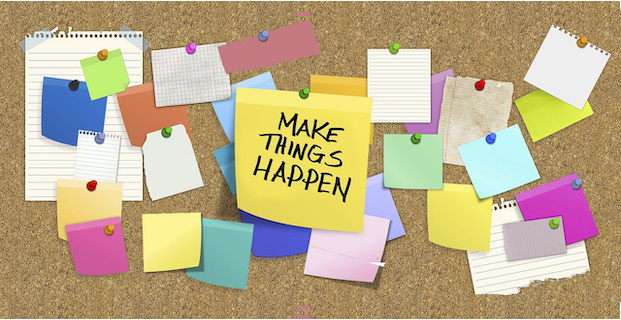by Elle Ray | Oct 21, 2019 | Agency Advice
Avoid the Effects of Stress on Your Work

Stress takes its toll in so many ways. It affects your physical and mental health, as well as your relationships, emotions and finances. If you’re like many people, coping with the stressors that invade your serenity each day often have their own consequences. Using drugs and alcohol to cope or relying on spending, gambling and overeating to ease the discomfort of stress just end up causing even more problems — and additional stress. It’s a spiral that just leads down.
When the place you spend the majority of your time is the main source of your stress, you may be headed for a major burnout episode if you don’t deal with it. According to the American Institute of Stress, “83 percent of U.S. workers suffer from work-related stress.” And the effects of stress on your work extend far beyond your own personal consequences:
- Workplace stress causes about one million people to miss work every day
- Businesses lose roughly $300 billion annually due to stress on the job
- Depression is one of the main effects of stress and the cause of those missed days, accounting for about $51 billion from absenteeism and another $26 billion for treatment
- Nearly 120,000 deaths are attributed to workplace stress every year
- About $190 billion in healthcare is spent on treating on-the-job, stress-related conditions
- Less than half of all employees believe that their employers even care
More Effects of Stress on Your Work
Work-related stress is understandable, especially when you’re a web developer, internet content provider or project manager. The flurry of changes you’re expected to deal with on a daily basis is dizzying:
- Tight deadlines with no room for mistakes
- Delays of others that impact your ability to complete your job
- Unreasonable customers who keep changing their minds
- Demanding bosses who don’t seem willing to give you the support you need
- Rapidly changing technology and algorithms that affect every project
- Competition only too willing to undercut your efforts
And if you happen to be the owner of a small content or tech company, you bring your own set of perfectly realistic stressors to work on a daily basis:
- Slow paying clients
- Demanding workers
- Employee turnover (especially in a wide-open job market)
- Personal finances
- Slow periods
- Pressures when all the jobs come in at once
Dealing with Stress at Work
In an ideal world, you can offset daily stress with a work-life balancing act that includes nutrition, exercise, fun and love. But it’s not an ideal world. To keep the effects of stress on your work to a minimum, you need to develop a new set of tips and tactics before you:
- Blow up and quit
- Fire everyone around you and end up doing all the work alone
- Make so many mistakes that you lose clients
- Tell off an important client in the heat of a moment
Every nuanced trick to deal with the effects of stress on your work won’t be effective for you personally. But a few tactics will work, allowing you to chill out and remember why you started your own business in the first place or why you went into the world of web design, web development or digital marketing. It’s OK to pick and choose or mix and match. Just do something to stop the madness that stress creates, such as:
- Always sleep on important decisions. Decisions made under duress or when you feel the tension of a stress headache coming on rarely lead to the best choices.
- Unplug at least one day every other week (or more). That means letting everything wait. By putting work in its place, you realize that while it’s important, your life and happiness rate just as high as any subjective deadline.
- Make lists to prioritize tasks that must be done today versus those items that can wait. As you go through your day, check off items that you’ve accomplished. Do one thing at a time and you may find that you suddenly have more time available! You can be productive when you’re focused and not rushed.
- Treat yourself and your employees after every success. It’s easy to rush from one project to the next without celebrating the victories. And soon enough, that win gets lost in the shuffle of the next stressor.
Ray Access is a content marketing firm that delivers targeted words that empower your business to succeed. Contact us about your specific project to receive a quote. We write website copy, blog posts, e-newsletters, and more, with cross-links and thorough internet research.
by Mark Bloom | Oct 15, 2019 | Agency Advice
Learn How to Avoid the Ills of Content Delay

Don’t let waiting for content put your company underwater
Every website development business, every web design firm and every content marketer has likely had an unpleasant experience dealing with content delay. A common scenario runs something like this:
- A company hires you to develop a new website, completely revamp an existing site or make some other kinds of tweaks to a site. You assign a contact from your team of project managers.
- For budgetary or other reasons, the client agrees to furnish the content for the new or updated site. Your project manager schedules milestone and deadlines.
- Your web designers work diligently with the client to produce the mockups for approval. Once approved, your web developers start coding the actual site.
- All along the way, your project manager checks in with the client regarding the promised content. As the deadline for the content approaches, the client stops replying to your emails and answering your calls.
- The deadline for content comes and goes with no word. Your team of web developers finishes the coding, but the project is stalled.
If this sounds familiar to you, you’ve experienced content delay. Even though you got at least a 50 percent deposit up front before you started the project, by this point, your expenses may exceed that amount. And without a responsive client, the end of the project is nowhere in sight. Welcome to the stress of content delay.
Decision Time for Project Managers
So you have some decisions to make. You can’t move forward on the client’s project. The coding is complete, except for any fixes or last-minute requests that can happen during the testing phase, but the testing phase can’t move forward without real content. It’s a dilemma that has to cause stress, even without the financial aspect.
You may continue to press the client for answers, but it’s soon obvious that your contact has left you in the lurch, had a serious accident, left for vacation without telling you or died suddenly. You reluctantly put the project aside and move onto other things. Your web developers and your project managers get involved in other web projects and forget about the incomplete project. Your team is back on track with a (hopefully) more responsive client.
Out of the Blue
A month or maybe two later, the original client reaches out to deliver the content and ask when the website can be finished. At first, you may feel elated, thinking that now you can be paid for all the work your team has done. And then you realize that your team is booked solid through the next two months.
Now you have to negotiate with the client, telling him the bad news while trying to assure him the site will be ready. All this adds to stress levels that are already high from running a successful small business. Content delay has repercussions for you and your team of web developers, project managers and graphic designers.
Solutions to Content Delay
To avoid the stress of content delays, you need a strategy for dealing with clients who let you down. You need to plan for content before it stops your website project. Some proven ideas include:
- Late fees. Attach fees to each milestone in your project plan. Your project managers will love the idea of added incentives. To get your clients onboard, tell them that the fees apply to your milestones too. If you miss a milestone, the client receives discounts or freebies. It may help prevent content delays when the client knows that he’ll have to pay more if the content is late. You can even make it progressive, so the longer the delay, the more the fees.
- Different pay structure. Instead of 50 percent up front and 50 percent on completion, break it up. Maybe every milestone has a payment associated with it. The deeper into the project the milestone, the less each payment is. It’s incentive to continue with your services.
- Put it in writing. If your client Is preparing the content, put the warnings of tardiness in the contract. You can use fees as incentive, but that may be insufficient. Make sure the client knows that if you have to put the project on hold due to a missed deadline, you can’t pick it right back up when the content finally arrives. In addition to the financial penalties, the project has to go to the back of the queue.
- Prioritize the content. If you’re worried that you won’t get the content on time, make the content a project priority. Tell the client you can’t start the website development until you have the content in hand. That’s certainly a motivating strategy. Introduce your client to a professional writing team to provide the content, if necessary.
- Assume responsibility for the content. Don’t allow the client to write the content, no matter how much he insists. This produces two wins: no content delay and better content for the site. If you have no content team, outsource it to a responsive and talented content writing firm, such as Ray Access.
When you hire third-party professionals to write the content for your client, you not only save time, money and headaches, but you also improve the quality of the overall product your team develops. Effective website content gets noticed by visitors and search engines alike. It also generates more leads for the client, another win for which a smart client credits you and your web developers.
Ray Access is a content marketing firm that delivers targeted words that empower your business to succeed. Contact us about your specific project to receive a quote. We write website copy, blog posts, e-newsletters, and more, with cross-links and thorough internet research.
by Elle Ray | Oct 7, 2019 | Agency Advice
Is Content Marketing Stress Catching Up to You?

It’s well-documented by medical and psychological professionals that too much stress harms your health. And while a little stress never hurt anyone and may even save your life in the right circumstances, chronic stress delivers some dangerous long-term consequences. And for web developers and content marketing pros who face stress on a daily basis, those consequences can come with a pretty high price tag.
Back when humans still struggled to survive their environment, a saber-toothed tiger attack stressed the body to respond with flight, fight or freeze. This built-in survival instinct is the reason humans aren’t extinct today. And that same response can still save your skin save you should ever find yourself down a dark alley in Detroit at night.
Danger, Danger!
Your body doesn’t know the difference between an imminent attack by a tiger or the looming deadlines of a website going live. It’s going to react with the same stress responses that makes your:
- Heart rate increase and blood pressure rise
- Muscles tense and breathing become rapid
- Adrenaline pump and senses heighten
The real danger for content marketing creatives and technical workers lies in your response to these bodily changes. Stress in technical careers is particularly high. Left unabated, they’ll take a pound of flesh as payment. There are many reasons why web developers, content providers, coders and project managers undergo such high levels of stress, including:>/p>
- Rapidly changing algorithms and tech tools you’re expected to master
- Understaffing and employee turnover
- Client pressure
- Approaching deadlines
- Security issues
- Lack of support
- High demand
The Irony for Web Developers
The reasons you got into the content marketing field may be the same reasons you’re thinking of chucking it all now to go dig ditches instead. While you love the challenges inherent in working in the internet industry, the pace is brutal. And while you like being in demand for your skills, sometimes, you just want to be invisible, even if for a long weekend.
The more clients you have, the more deadlines you have to meet. If you work in the corporate tech arena, you’re lucky if the big dogs even understand the support you need to give them what they want. And if you’re among the top web developers in your field, there are all those untalented wonks you’re constantly training — until you resort to the last resort as many web developers do and say “never mind, I’ll just do it myself.”
Mind over Matter Management
There’s little you can do about the rapid-fire changes in the tech industry. New devices, apps and algorithms come at you so fast, you barely have time to finish your morning cuppa java. The trick to avoiding burn-out (or a heart attack) is to manage those things you can control — which usually means YOU, the only thing you total control over in any situation. You control how you react to and think about the changes, the pressure, the competition and the completion of each project.
You control your health and how you take care of your body, soul and mind. You control the pace at which you’re willing to work. You say when it’s time for a break, a vacation, a little less screen time. You are in demand, so you aren’t the one who has to worry about job security.

Tips for Web Developers to Manage Stress
Like the flyer who first puts the oxygen mask on herself to save less-able passengers, you’ve got to take care of yourself to avoid the consequences of chronic stress that range from headaches and back pain to insomnia and anxiety. Tips that work for all humans to reduce the risks of too much stress are good for you too.
So take these tips to heart. They may work for you, while encouraging you to take your content marketing skills to the next level. Plus, you get to enjoy your life, staying healthy and keeping your job, by:
- Get physical. Most gyms are open from early morning until late at night, some even 24/7. Make it a regular habit to go. Ask for a gym membership as a non-negotiable term of your employment.
- Peace out. Find your happy place, preferably one that doesn’t require you to stare at a screen. Join an Ashram or do yoga. Walk a labyrinth. Build a little, calm altar that allows for peaceful, quiet meditation. Anything you can do to stay centered and calm pays dividends in your stress levels.
- Laugh out loud. Check out the local comedy club on a regular basis. Subscribe to a joke-a-day blog. Watch funny movies. Learn to tell jokes. When something strikes your funny bone, laugh as if no one’s watching.
- Just hang. Spending time with friends and family provide a wonderful break from the stress that solitary web developers must endure. Seek those people who make you laugh, who let you feel relaxed and who bring you fulfillment.
- Dance to be free. Get a hobby. Learn a new dance technique. Garden, paint, play music, whatever. Do anything unrelated to content marketing to free your brain and your break your concentration. This technique also sharpens your creativity.
Ray Access is a content marketing firm that delivers targeted words that empower your business to succeed. Contact us about your specific project to receive a quote. We write website copy, blog posts, e-newsletters, and more, with cross-links and thorough internet research.
by Elle Ray | Sep 24, 2019 | Agency Advice
Businesses Can’t Have One Without the Other

Some say that creativity and sales go together about as well as barefoot hiking and fire ants. No matter how you try it, someone’s gonna feel pain. After all, creativity requires that you break through boundaries and let your imagination soar to produce something pure and unique. The process of sales involves contracts and signatures and an exchange of money for goods or services.
The two hardly seem to exist within the same reality. And yet, not only do they coexist, but they’re so entangled that one cannot successfully exist without the other. The question then becomes: How can creatives build up enough sales to sustain their work?
The Art of Sales
Sales training experts tell you that sales is an art form in and of itself that requires:
- Ingenuity
- Creativity
- Communication skills
- Persuasiveness
- Personality
- Perseverance
Lo and behold, those are many of the same qualities required of an artist. But just as an artist may be loath to talk about the features and benefits of her work, so the professional salesperson may just as soon cut off her hair as sit in solitude to write a poem or paint a picture.
The fact is that in order to pay the bills and have enough money to buy more paint, the graphic artist must sell her work, the writer must get published and the sculptor must subsist on more than clay. Inventors, architects and designers need solitude to fuel the creative process, while salespeople need more people with whom to interact. Then dare we say that embracing the similarities between the arts of creativity and sales — instead of thinking of them as frenemies — just may be the ticket to a long, successful career as an independent creative.
Twain the Two Shall Meet
Linda has had successful careers in both sales of consumer goods and creative endeavors as a writer. But she really dislikes mixing the two. To grow Ray Access into a successful content provider business, we’ve had to put on the sales hat or rely on others to sell our services. There comes a time when it just takes too much energy to be constantly switching hats — and the matching shoes and outfits. So we let others carry that mantle. We prefer to produce than peddle, though we must say we like the income as much as any high-powered, competitive sales pro.
Perhaps the best solution for mixing creativity and sales is to go the way of the corporate model that keeps creatives locked away to do their things, while the sales stars hit the streets. Let the project managers keep them both aligned and free from the day-to-day bothers of the others. And even if we don’t go all LLC or S-Corp on our businesses, we can at least realize that we need help from each other.
Respecting the Process
As a creative, you may prefer a life of poverty mixed with glimpses of success before you’d ever consider designing to sell. As a go-getter who loves the art of the deal, solitary confinement equals a jail sentence. On the other hand, if you’ve mastered the ability to move between the worlds of creativity and sales, you can probably tell us all about your success at your next IPO or catered launch party.
At the very least, creatives and sales professionals need each other to survive. A sales pro wouldn’t have anything to sell if it weren’t for the creatives who designed the services and products they hawk. And creatives would end up smothered in a room full of beautiful art if it weren’t for the diligent efforts of the salesperson.
Whether you deign to remain a solopreneur, partner up with another creative or seek a spot in a corporate creative environment, you do need to respect the work of the sales artisans who draw on their own brand of creativity daily for the good of the whole — including the creatives. Mutual respect is required to make creativity and sales work harmoniously — if not side by side, then at least in the same realm of reality.
Ray Access is a content marketing firm that delivers targeted words to empower your business. Contact us about your specific project to receive a quote or discuss your needs. We write website copy, blog posts, e-newsletters and more. Everything we do is thoroughly researched, professionally edited and guaranteed original.
by Elle Ray | Jul 30, 2019 | Agency Advice
Content for Developers Make or Break a Site
Website developers create websites, blogs and plug-ins for newsletters, shopping carts and other electronic business necessities. They use different platforms and styles to build their sites, but it often falls within the purview of a web developer to come up with color schemes and designs.
An effective website is made up of many essential pieces. Because of the very nature of websites, content for developers often comes from other sources, such as:
- Graphic designers
- Photographers
- Writers and editors
- Marketing consultants
- SEO specialists
- Videographers
- The clients themselves

In-House or Outsourced?
Any large web development company often employs professionals with the key skills needed to create a website. you may be able to keep a staff prepared to deliver all the necessary components required for a complete package. Outsourcing content for developers to niche, third-party operations like Ray Access, which only provides writing and editing, is a simple and efficient way to handle your company’s needs.
Keeping all the tasks in-house means that your development team must include more project managers and supervisors, forcing a bigger payroll. But you may not always have enough work to keep everyone busy on a full-time basis. When you outsource content for developers, you only have to call on the third-party vendors when you need them. And once you find a third-party provider you trust, the need for oversight disappears.
Benefits of Outsourcing Content for Developers
In addition to the payroll and supervisory positions web developers can avoid when they outsource, web developers receive an abundance of other benefits they may not really appreciate until they’ve tried the outsourcing business model.
Features and benefits that niche firms offer in the form of content for developers include, but certainly aren’t limited to:
- Being able to set firm deadlines that third-party vendors adhere to. Contractors know the value of meeting deadlines, especially if they want to keep getting more work from that developer. After all, having projects slowed down waiting for content in one form or another is one of the banes of the developer’s existence.
- Relying on professionals that keep up-to-date on best practices of their particular specialty. Contractors must know their area of expertise. So that means web development companies don’t have to bother with continual in-house training. Content for developers designed by specialists follows current design trends, and those change quickly in the online environment.
- Taking responsibility off the client is an advantage that most customers appreciate. Building relationships with content providers means developers can confidently offer a complete package to clients without having to hire and train a team to do the work, or at least that part of it.
- Paying for content is rolled into the final quote developers give to clients. In this way, the customer knows what the total budget consists of for a final, ready-to-go-live site. Additionally, the practice of outsourcing content for developers gives the developers a cushion onto which they can add a percentage, increasing their own profit margins.
Massaging the Message
Most website designers and developers understand that an effective website is more than just a pretty face. A site can have the flashiest graphics and hottest new interactive features, but if customers can’t find what they’re looking for or if they don’t understand quickly what makes that business special, then that website is nothing more than eye candy.
You must seriously consider the content you use on a site to bolster its effectiveness. Messaging should be a top priority, allowing the site plan, design and content to fit seamlessly together in the final presentation. When a company’s customers visit its website and the content answers questions and makes searching for information easy, the web developer’s clients make sales. And when those clients need to revamp their site, the developers who’ve spent time and energy building a strong outsourced team will get that call!
Ray Access is a content marketing firm that delivers targeted words to empower your business. Contact us about your specific project to receive a quote or discuss your needs. We write website copy, blog posts, e-newsletters and more. Everything we do is thoroughly researched, professionally edited and guaranteed original.
by Mark Bloom | Jul 16, 2019 | Agency Advice

Create Landing Page Content That Drives Sales
You won’t find a magic formula that delivers customers to your business via the internet. You can’t copy a template, change the landing page content and assume your business will prosper. Every business, it seems, has to figure out for itself what works.
Still, best practices exist. Every landing page needs certain elements to be successful, even though those elements can look very different from page to page. So while there’s no magic formula that works every time, a framework in which to operate does exist. But first, let’s agree on the definition of certain terms.
What You Need to Know First
When talking about landing page content, you must understand the key terms. This article defines these terms as follows:
- Web page. A website page is a page on your website. The Home page is your root or base page, from which visitors can access your other pages (for example, About or Contact). Due to the nature of search engines, visitors may not always enter your site from your Home page.
- Landing page. This website page is not the same as your Home page. It’s a specially-created page that may not even be accessible through your website navigation menu. Its job is to get visitors to follow through on a call to action. It’s the focus of this article.
- SEO. Search engine optimization is the practical science behind ranking high in a search engine results page (SERP) to draw more traffic to your website. SEO encompasses many techniques because what works best is constantly changing, based on the search engine algorithms.
- Search engine algorithms. Each search engine, such as Google or Bing, uses a formula to determine which website or web page ranks higher than the others on a SERP. The algorithms are controlled by the search engines, and they change from time to time.
- PPC. Pay-per-click advertising is a standard internet model for advertising. For PPC to work, you build an ad that shows up when someone searches for a specific keyword or keyword phrase. You only pay when people click on your ad — but you pay whether they buy from you or not.
How Does a Landing Page Work?
If you’re running a PPC campaign, the ad should direct all traffic — on the click — to a landing page with content that reaffirms what the ad claimed. If you’re using an email marketing campaign, the technique is different, but the result should be the same: a clickthrough that sends the email recipient to a landing page.
Never send a potential customer to your Home page from a targeted marketing campaign because it often contains too much information, too many things to do and very little direction.
Your landing page content must contain a targeted message written to connect with the person who landed there. Whoever clicks though to your landing page already has interest in one of your products or services. All you have to do is persuade him to act. That’s the purpose of a landing page.
The Elements of a Successful Landing Page
Since landing page content is by nature rhetorical — in other words, its purpose is to persuade a person to act or behave a certain way — the language needs to connect to the specific target audience. The best way to connect and to get people to act is to reach them on an emotional level. To do that, every landing page needs to feature elements such as:
- A re-enforcing heading. If your PPC or email campaign promised a solution to a problem, the heading should reiterate the problem and promised solution. This technique lets visitors know they landed in the right place.
- A sub-heading that promises an answer to a problem. The sub-heading is eye-catching and is the second thing a visitor is likely to read. It should contain an “umpf” factor that supports the reason the visitor has clicked through to the landing page.
- An engaging photo that visitors can relate to. Think about what a customer will look like when he buys your product or service and uses it successfully. What’s the outcome and how can you capture it in an image or video? Landing page content isn’t complete without graphics.
- The benefits of your product or service. How does what you’re offering solve people’s problems? Why should someone buy from you and not your competitors? In short: what’s in it for them?
- Social proof. You need testimonials. You need photos of smiling customers to accompany those testimonials. And they need to be real and verifiable. If potential customers see that others have used your product or service and rave about it, that’s strong marketing medicine.
- A strong call to action. Don’t litter your landing page content with lots of options. Your landing page needs but one distinct call to action, whether it’s to sign up for your newsletter, buy your product or service, contact you for a special offer, whatever. Your call to action needs to be compelling and unavoidable. The best calls to action add time-sensitive reasons for acting right away.
So How Much Landing Page Content Do You Need?
There’s no magic number that ensures success. If you’ve included all the required elements, your landing page can be 250 words or 1,000 words. The answer often depends on your target market, as it does for many business decisions. Do they read at length? Do they prefer video? Do they really need a lot of reinforcement or are they ready to buy when they click through to the landing page?
Your best bet is to cover your bases. Make sure the elements are covered completely. Make sure every graphic is needed and adds to the story you’re creating. Just like on every normal web page, everything you put on a landing page should contribute to the purpose of the page. If you think your landing page content is too long or too short, test it on different audiences. A/B testing is a staple of marketing. But that’s another subject.
Ray Access is a content marketing firm that delivers targeted words to empower your business. Contact us about your specific project to receive a quote or discuss your needs. We write website copy, blog posts, e-newsletters and more. Everything we do is thoroughly researched, professionally edited and guaranteed original.







